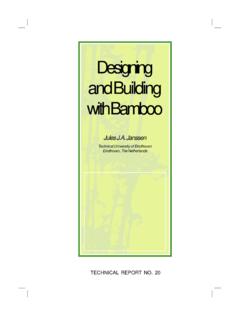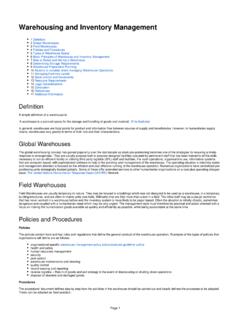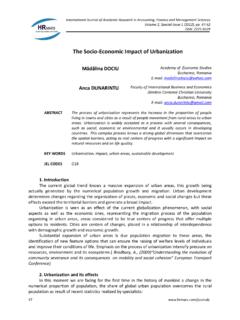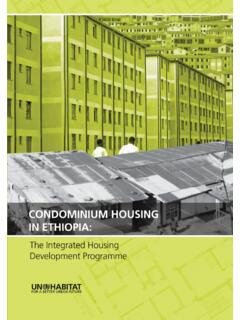Transcription of Construction in Ethiopia - Humanitarian Library
1 1 Summary As the intensive Construction in Ethiopia today becomes more complex, the demand for housing and project man-agement services is increasing. During the housing con-struction the application of project management the pro-gress against time, cost against tender or budget, quality against specifications is can be confusing for all parties involved in the Construction process. Therefor, the main task of this paper is to indicate the problem solutions. This menace, first of all any project before its design starting should have a briefing stage, sketch design stage, scheme design stage and detail design. Also design should include the climatic design of building materials, earth-quake safety and energy conservation for low cost hous-ing as well as for complex buildings. Apart that, to have quality and effective Construction work there should be quality control. Introduction Even though Ethiopia has it s own several ancient civili-sations, from the 60s there is a great influence by the in-ternational style of architectural design.
2 Because of these, every building is reduced to plain vertical and horizontal lines of concrete blocks, which being unimpressive and ugly, are a menace to the society and a cause of environ-mental degradation. They are also a cause of a complete break to traditional values and cultural patterns. Apart from that, because of the international style influence, the country can not relate itself with tradition while, we have not yet been to able satisfy the basic housing needs of our people even with the modern solutions. But I think, it is very important to learn from mistakes done on built hous-ing blocks that were implemented with out thorough study of function. And it is important to encourage con-struction of buildings with local materials and of course with consideration of functional requirements and proper management. Aim of the paper As the intensive Construction process of today becomes more and complex, in Ethiopia the demand for profes-sional project management and real design services are increasing.
3 People within the Construction do not agree about what the concept project management implies and this can be confusing for all parts involved in the con-struction process, including a client who intends to hire a Management Company. My main objective in this paper is to highlight a gen-eral understanding of project problems with real design, tendering, and management and present my own propos-als and solutions to the problems. Basic Information about Ethiopia Location Ethiopia is located in the Horn of Africa and is the largest country in the continent. It has an area of 1,112,000 km and it has an elevated central plateau varying between 2,000 and 3,000 meters above sea level Figure 1 Map of Ethiopia Population The population of Ethiopia is about 58 million. According to the 1997-population census. The population living ur-ban areas accounted for about 15% and 50% of the popu-lation are under 22 years of age. The average number of inhabitants per km is estimated to be 26 people.
4 Structure of the Construction industry The Construction industry consists of various sectors. These are the building and residential development sector, civil engineering sector, professional services sector and Construction in Ethiopia Alem Tesfahunegn Civil engineer (MSc) Building Design Enterprise Ethiopia Alem Tesfahunegn 2 self-building sector. The Construction industry consists of deferent types and size of firms. These operate in the def-erent sub-markets characterising the Construction indus-try. Construction firms must be registered and licensed in order to undertake any Construction work in Ethiopia . The firms are classified according to size, expertise and finan-cial capability by the ministry of work and urban devel-opment (MWUD). The self-building sector is character-ised by an informal sector, consisting of informal groups that supply materials and labour. These informal groups are not licensed or registered. However, they employ a great number of people. The professional services sector consists of architects, civil engineers, electrical engineers, sanitary engineers, and mechanical engineers, quantity surveyors and surveyors who provided the design exper-tise.
5 The services of these consultants are not utilised in the informal and self-build sectors. There exists a great separation between the design consultants and the con-tractors. This generates conflict in the Construction proc-ess and results in project delays and cost escalations due to claims. It is important that methods for conflict mitiga-tion are developed for the industry. Design of buildings The design process The design process in building design enterprise (BDE) and other consultants of the design of buildings in the formal sector is a co-operative effort between the client and various consultants. The client provides a set of re-quirements and constraints that the consultants attempt satisfy during the design process. To satisfy the client brief, a design team is constituted which consist of all the consultants. The team in most cases is headed by the ar-chitect or by the consultant in recent times. The consultant is appointed by the client and takes care of the client s in-terests according to the general condition of Construction .
6 The contributions of each consultant in the design process can be summarised as follows: Brief Stage Client provides the design brief that consists of the re-quirements and constraints to the design team. Sketch Design Stage Architect prepares a preliminary sketch to satisfy the de-signs brief and possibly provides alternative proposal. Quantity surveyor prepares preliminary cost estimates based on the Architect s design sketch. Quantity surveyor provides the initial cost plan that forms the basis of cost control and budgeting. Client approves sketch and cost es-timates. Scheme Design Stage Architect designs to a greater detail to meet the submis-sion requirements of the local authority. Quantity sur-veyor undertakes various costs, checks and ensures that the budget is not exceeded. Architect provides scheme de-signs to the civil (structural), mechanical and electrical engineers for the engineering design of the project. Archi-tect submits scheme design for approval to the local authority.
7 Detail Design Stage Architects proceed to detail design the elements and com-ponents of various spaces and prepares specification for the project. Quantity surveyor prepares bills of quantities and final cost check. Engineers finalise their drawings and specifications. Climatic Design of Buildings The decision to incorporate climatic design criteria is based on the climatic conditions prevailing in a given area. The most common design parameters employed in passive design of buildings in Ethiopia include orienta-tion, shading, ventilation, glazing and terminal properties of materials. Building materials In Ethiopia the major problem is building materials, espe-cially the roofing materials. As a common practise round tree (usually Eucalyptus tree) and corrugated iron sheets are widely used. Today, these materials have become very expensive so that low-income people are almost unable to build their houses. Reinforced concrete slabs were tried, but they were found out to be difficult to make water tight in most constructions.
8 This in fact could be improved if proper management and good quality control of materials were available. But for low cost houses, a rather cheap roofing material should be introduced. Several research works are still on the way to find a replacement for the corrugated iron sheet. Even though concrete results are not yet obtained. Earthquake safety Since the Great Rift Valley pass through Ethiopia , some cities are categorised under the seismic zone of Ethiopia . Now days due to this, every building is designed consid-ering the expected maximum earthquake loads. According to the Ethiopian standard code of practise, comparisons Between wind loads and earthquake loads are considered and every building is designed based on the worst condi-tion. Building regulations The building code sets out building regulations and re-quirements. It is a legal document and it confers powers to all the local authorities to over see that the building code and building by-laws are maintained in the areas of their jurisdiction.
9 But since the housing policy of Ethiopia was not strong in the past, several disorganised urban plans, designs, Construction methods are visible. To over-come these problems, research works on up grading low-income housing, proposing new low-cost housing pro-jects, introducing new sanitation methods, use of local building materials and transfer of Construction technology are still in progress. It is my belief that the out come will be beneficial and applicable in the country to somehow overcome the housing problems of the country. Construction in Ethiopia 3 Standardisation Standardisation in building is a process of creating vari-ous elements in building to a certain specification size and quality. Standardisation is an important principle of ra-tionalisation and requires that buildings be built of stan-dardised components. The other benefits of standardisa-tion include reduced Construction time, improved quality and reduced costs. In Ethiopia there has been standardisa-tion programs in the industry, and also major manufactur-ers have been offering standardised product range.
10 Stan-dardised materials available to the industry include roof-ing materials, pre-cast concrete materials, steel windows, doors and electrical fittings. Energy conservation Ethiopia s main sources of energy are wood fuel, petro-leum and hydro electricity. Alternative sources of energy like biogas; solar energy is being developed. Ethiopia is currently facing energy crisis. For example even though housing problems exist, the growth in demand for elec-tricity is more than expected and the situation is more se-rious for fuel wood, where the shortages have led to rise in prices of charcoal. Use of fuel wood is also an impor-tant cause of deforestation. Energy conservation guideline for buildings does not exist and energy use is not regarded as major design criteria in buildings. The designers are designing more and more energy incentive buildings that relay more on air-conditioning, artificial lighting and me-chanical ventilation systems. There is a need for research studies on energy use in buildings and the possibilities of energy conservation.






